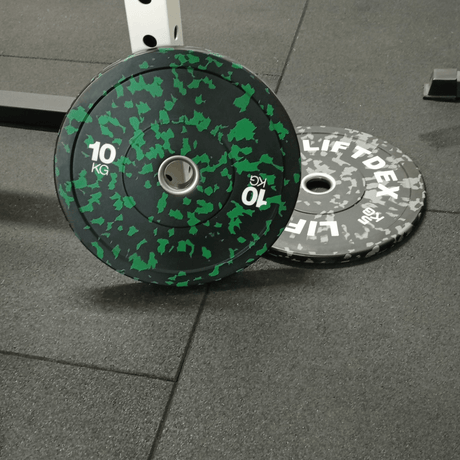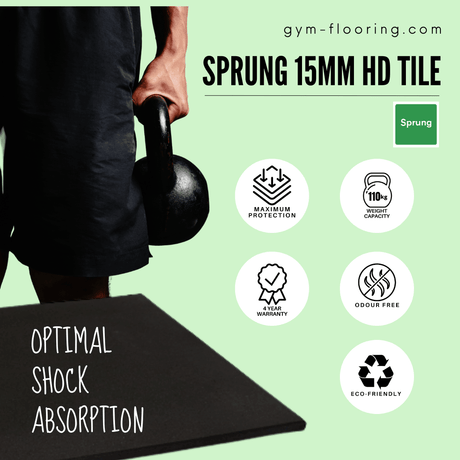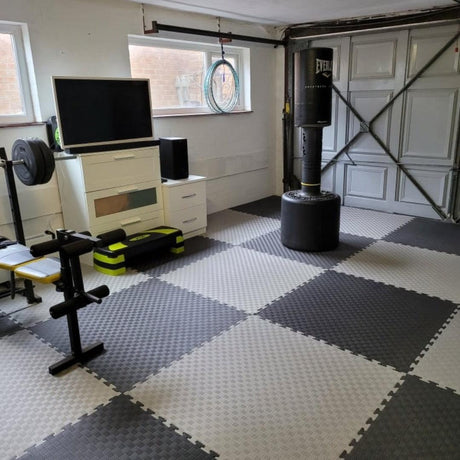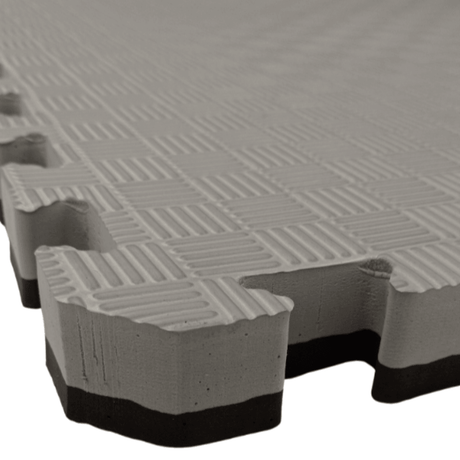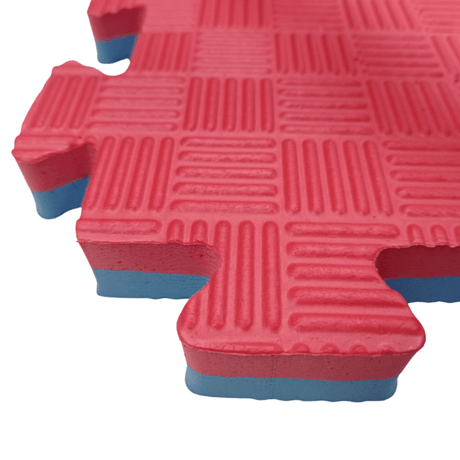A gym is only as good as its floor. If you value performance and developing your fitness and training then a proper gym floor is essential. Often overlooked, a gym floor can be one of the last things people consider when designing or building their home or commercial gym even though it is at the very core of each workout that you do whether it is Strength Training with Weights or bodyweight and functional exercises.

What is a proper Gym Floor?
Gym floors are specially designed flooring systems that provide a safe and durable surface for exercise and physical activity. Gym floors can be made from rubber, foam, PVC or Wood and often have a textured or non-slip surface to prevent injuries. Gym floors must be able to withstand heavy use and abuse, so they are often thicker and more durable than standard flooring.
Most commonly, rubber is the chosen material as it is available in a number of thicknesses, sizes and does the best job of protecting the subfloor and user. Available in tiles, mats and rolls, rubber gym flooring comes in various colours, design and installation options such as interlocking and Jigsaw profiles which make the fitting process very simple.

The Importance of Gym Flooring
Gym flooring is an important part of any gym or workout space. It can help protect your equipment and floors from wear and tear and provide a comfortable surface for you to exercise on. Gym flooring can also help reduce noise and vibration, making your workout space more enjoyable for everyone.
Here are a few reasons why gym flooring is so important:
- Protect Flooring - Gym flooring can help to protect your underlying floor from damage. This is especially important if you have expensive flooring, such as hardwood or concrete. Gym flooring can also help to reduce noise and vibration.
- Improve safety - A good gym floor will provide a safe, non-slip surface for exercise and physical activity. This can help to prevent injuries.
- Increase durability - Gym floors are designed to withstand heavy use and abuse. This means they will last longer than standard flooring.
- Versatile - Gym flooring can be used in commercial facilities as well as Home Gyms. Similarly, a gym floor can accommodate a number of fitness activities from classes to weights and cardio equipment.
- Easy to clean - Proper gym flooring is simple to maintain with an easy care cleaning routine and general upkeep.
Types of Gym Floors
When it comes to outfitting your gym, one of the most important decisions you will make is choosing the right type of flooring. Not all gym floors are created equal, and the type you choose will greatly impact the look and feel of your space and the safety of your equipment and clients.
A gym equipment floor is a big investment, so it's important to do your research and choose the option that best suits your needs. To help you make the best decision for your gym, we've put together a guide to the different types of gym floors available on the market.
1. Interlocking Rubber Tiles
Interlocking tiles are one of the most popular gym floor options on the market. Some feature hidden inserts that connect the tiles together while others are designed like a Jigsaw puzzle with each piece slotting together. This offers additional stability and keeps the tiles in a secure position during intense workouts and heavy traffic. One of the main benefits of interlocking tiles is that they are easy to install without specialist assistance or costly accessories.

2. Rolled Rubber
Rolled rubber flooring is another popular option for gyms because it covers wide areas and cuts down on waste. It is ultra durable, slip-resistant, and easy to clean. It also has some sound-dampening properties, which can be beneficial if you have classes or music playing in your space. Rolled rubber comes in a variety of thicknesses, so you can choose an option that best suits your needs although they tend to come in less thicker options than tiles, starting from 4mm to 12mm.

3. Standard Rubber Gym Tiles
Recycled rubber gym tiles are a staple in most functional gym spaces. They come in a choice of sizes and thicknesses usually ranging from 11mm right up to 60mm for serious heavy lifting. Available in colours and patterns, these tiles are simple to fit DIY as in most cases they come with a Tutorial video and fitting guidelines.

4. Foam Tiles
Foam tiles are a softer option that is often used in areas where people will be doing a lot of floor work, such as yoga or Pilates. They are also the go-to choice for sports such as Boxing and MMA. Foam tiles are widely used in child care facilities or any other space where small children might be present. Foam tiles are available in a variety of colours and thicknesses so that you can create the perfect look and feel for your space.

5. Synthetic Gym Turf
Synthetic gym turf has soft, grass-like fibres that are comfortable to walk on and provides good traction. It comes in rolls or track forms for sprinting and sled-pulling.

One of the biggest advantages of synthetic turf is that it is very versatile and can be used for a variety of uses. It allows commercial facilities to create dedicated zones for different exercise types which maximises space and functionality.
Considerations for Choosing Gym Flooring
When choosing gym flooring, there are a few key considerations to keep in mind to ensure that you make the best choice for your facility. Let's take a closer look at a few of the most important factors to keep in mind when choosing gym flooring.
1. Main Uses
The type of exercise you'll be doing in your gym is one of the most important considerations in choosing the right flooring. If you're going to be doing a lot of high-impact activities like Weight Training, for example, you'll need flooring that can withstand heavy loads and therefore thicker gym flooring will be needed. A yoga studio, on the other hand, will need flooring that's more comfortable and forgiving on the joints and a softer material might be the best option.
2. Installation
An important factor to think about is installation. How simple is it to fit? Would I need a specialist installer? Do I need to level my subfloor for this type of flooring? Will this type of gym floor fit with my existing space and its condition? These are all questions you should ask before making a final decision on your flooring.
3. Maintenance
The maintenance required for different types of gym flooring can vary greatly. Some flooring is very easy to maintain, while others require more work. If you're looking for low-maintenance flooring, make sure to choose a material that is easy to clean and won't require a lot of special care. For example, Wood is hardwearing but can get easily scuffed and scratched meaning costly maintenance to sand and reseal the surface. Rubber is a great option for simple maintenance as it is easily repaired and doesn’t require constant upkeep.
Final Thoughts
The floor of your gym is just as important as the equipment and the walls. It's what you walk on, it's what you exercise on, and it's what supports all of your equipment. It optimises your workout performance allowing you to focus on technique and form without worrying about injury or tripping over. If you are designing a gym, it is advisable to make your gym floor choice a priority from the beginning of your project. This will save you time and money but most importantly your gym floor will perform for years to come.




